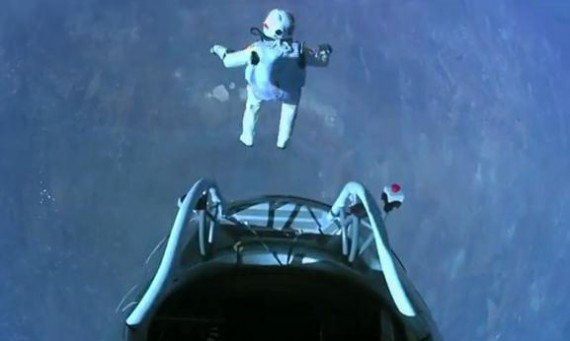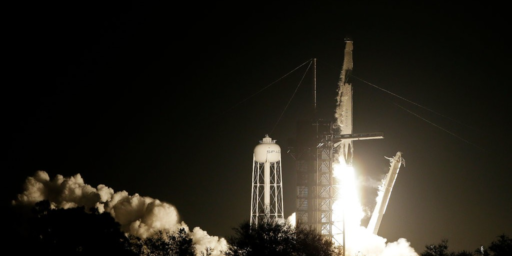Felix Baumgartner Completes Successful Jump From 128,100 Feet Above The Earth
Simply amazing.
There aren’t very many words that one can use to describe what it was like to watch the live coverage of what, upon reflection, seems like an absolutely insane stunt. For two hours, Austrian pilot, skydiver, and daredevil Felix Baumgartner sat in a pressurized capsule as it rose, attached to a massive helium-filled balloon. He sailed passed the point where most skydivers would even consider making a jump, past the point where commercial jets fly, past the Jet Stream, past the point where pressure drops so low that all the fluids in a human body would boil away in seconds, and past the point where the SR-71 used to fly. He sailed upward past the point where Joseph Kittinger, who was on the ground as his only contact with Earth, had jumped back in 1960, and past the highest point a manned balloon had ever sailed. Finally, at the height of 128,100 feet, more than 24 miles above the Earth, he jumped out:
ROSWELL, N.M. — Felix Baumgartner, the professional daredevil, said he was not thinking about setting records or collecting scientific data in the moments before he jumped from a capsule more than 24 miles high.
He was just thinking about making it back to Earth.
“Trust me, when you stand up there on top of the world, you become so humble. It’s not about breaking records anymore. It’s not about getting scientific data. It’s all about coming home,” Mr. Baumgarter said after returning by helicopter to mission control in Roswell.
“It was harder than I expected,” he said.
People around the world watched on the Web as Mr. Baumgartner stood on the edge of his capsule completing a final checklist, then jumped into a near vacuum at above 127,000 feet, or more than 24 miles. Minutes later he landed on his feet in the eastern New Mexico desert, and lifted his arms in victory.
Back at mission control and in a waiting room, his support team and family cheered.
Mr. Baumgartner, 43, a former Austrian paratrooper, took 2 hours 21 minutes to reach the height, lifting off in an enormous helium balloon that smoothly carried him through the critical first 4,000 feet — called the Dead Zone because it would be impossible to parachute to safety if something went wrong at that point.
From the sky above the New Mexico desert he had hoped to make the highest jump in history and become the first sky diver to break the speed of sound.
His leap seemed to be the longest ever, beating the existing distance record by about 25,000 feet, but exact times, distances and other records were not immediately known; mission control said it first needed to retrieve the data from computer chips in Mr. Baumgartner’s suit.
Before the jump, Mr. Baumgartner went through a checklist with help from Joe Kittinger, 84, the retired Air Force colonel who in 1960 jumped from 102,800 feet, setting records that remained more than half a century later — which Mr. Baumgartner was hoping to break.
During the second hour of ascent, Mr. Baumgartner complained to Mr. Kittinger that the heating system in his visor was not working properly, and the visor was fogging up. At that point viewers following the live feed of the mission stopped hearing the men’s conversation. The Red Bull Stratos team said that Mr. Kittinger had decided to “enable private conversation.”
After his leap into space Mr. Baumgartner again complained about fog in his visor, but it did not seem to impede his ability to gain control during his fall.
The mission required the largest balloon ever used for a manned flight. Made of 40 acres of ultrathin plastic, it had been described as an inflated dry-cleaning bag that would fill the Los Angeles Coliseum.
When inflated and attached to Mr. Baumgartner’s pressurized capsule, the balloon towered 750 feet above the ground.
An earlier attempt to inflate the balloon and carry out the mission had to be abandoned last week because of weather. The winds at the balloon’s height and at the ground had to be less than three miles an hour for it to be launched safely, so that there was no chance of the balloon lurching and smashing the capsule into the ground.
Until the last minute on Sunday, it was not certain that the mission would actually happen.
Mr. Baumgartner, wearing a pressurized suit to survive in the near vacuum at the edge of space, had hoped to reach a speed of more than 700 miles an hour.
He was backed by a NASA-style mission control operation at an airfield in Roswell that involved 300 people, including more than 70 engineers, scientists and physicians who have been working for five years on the project, called Red Bull Stratos, after the drink company that has financed it.
Besides aiming at records, the engineers and scientists on the Red Bull Stratos team are gathering and publishing reams of data intended to help future pilots, astronauts and perhaps space tourists survive if they have to bail out.
“We’re testing new space suits, escape concepts and treatment protocols for pressure loss at extreme altitudes,” said the Red Bull Stratos medical director, Dr. Jonathan Clark, who formerly oversaw the health of space shuttle crews at NASA. “There are so many things that could go wrong here that we’re pushing the technical envelope.”
As it turned out, and as covered in the just concluded post-jump press conference, Baumgartner jumped out at 128,100 feet above the surface, more than 24 miles high, and, most astoundingly of all perhaps, he hit a maximum speed during his freefall of 833.9 miles per hour. That’s Mach 1.24, folks. Faster than any human being has traveled without the aid of machinery. That means Baumgartner broke three records. He completed the highest successful jump in human history, he completed the highest manned balloon flight, and for a few brief seconds he became the fastest man on the planet. The only record he didn’t break is the record for the longest freefall. That record is still held by Joe Kittinger. In retrospect, Baumgartner could have held off pulling his chute for at least another minute, but right before the chute deployed he was saying on the live feed that his visor was fogging up, likely due to the issues that they had been having with the heating mechanism during the ascent. It’s possible he deployed the chute because of that, or because he simply couldn’t see his altimeter anymore.
This jump was originally scheduled to take place several days ago but had to be aborted due to strong winds at high altitudes that could’ve sent the balloon drifting far out of control. Appropriately enough though, it just happened to take place on the 65th Anniversary of the day that General Chuck Yeager (USAF, Ret.) broke the sound barrier. In fact, General Yeager, marked that occasion himself by doing it again at the age of 89:
NELLIS AIR FORCE BASE, Nev. – Sixty-five years after becoming the first human to fly faster than the speed of sound, retired Air Force Brig. Gen. Chuck Yeager is still making noise.
The 89-year-old Yeager, who was featured in the movie “The Right Stuff,” flew Sunday in the back seat of an F-15 Eagle instead of the experimental rocket plane, Bell X-1, he piloted on the historic flight.
The F-15 took off from Nellis Air Force Base near Las Vegas and broke the sound barrier at more than 30,000 feet above California’s Mojave Desert where Yeager achieved the feat on Oct. 14, 1947.
Yeager wasn’t the pilot this time, but I think he deserved to take the scenic route this time.
As for Baumgartner, I really can’t describe what it was like to watch this happen live. After Jazz Shaw had clued me into all this a couple weeks ago, I began to understand the dangers that this mission face notwithstanding all of the technology, backup systems, safety precautions, and abort points that they might have built into the mission. Felix’s attempt at this was certainly safer in many respects than Colonel Kittinger’s was 52 years ago, but there were still so many little things that could have gone wrong that the outcome was by no means predetermined. Indeed, when the mission reached that point where the balloon had effectively reached its maximum height, the cabin was depressurized, and the door to the stratosphere was open, there seemed to be several moments where Baumgartner hesitated as he and Kittinger went through the final pre-jump checklist. Kittinger seemed to be coaxing him back to reality just a little bit. I’m not sure if it was nerves or oxygen deprivation, but whatever the reason is, I’m certainly not about to complain about someone hesitating a little bit when they’re looking down from 24 miles above their home planet. The fact that he even when through with the act is testament enough as far as I’m concerned.
We’re told that this endeavor will garner important scientific data or NASA and other researchers who are working on the next generation of spacesuits, and for that reason alone it might well be worth it. However, it strikes me that it’s worth it for another reason. It’s a testament to the human spirit, and we haven’t seen many of those in recent years.
Here’s the video of the jump, at the beginning you’ll see some of the evidence of the hesitation and/or oxygen deprivation that I was talking about:
Update: Here’s a clip from a documentary that includes video of Joe Kittinger’s jump:







I like jumping out of planes, but that’s just crazy!
Not crazy. He tried and succeeded. It was a very carefully planned and executed mission. As Doug said, it was a great testament to the human spirit. And I eagerly await the scientific, medical, and technological advances that will result from this.
Win/win, however you like to look at it.
Red Bull gives you
wiiings40 acres of ultrathin plastiiic!!!An amazing feat. Considering my acrophobia is so bad that I cannot even venture off the high dive, this is beyond comprehension. Amazed to witness this.
Nitpick, but the human bodily fluids won’t boil away past the Armstrong Limit. Only the ones that are exposed to vacuum will do that (like sweat and saliva).
I’m just trying to comprehend what it might be like to tumble at 700 mph. He did seem to have bit of upset when he picked up enough atmosphere to slow him. That he was able to recover is amazing. That interface has been known to rip blackbirds apart.
The mental preparation for doing something like this must have been so intense. We use phrases like ‘losing one’s nerve’ as if he were about to ride a motorcycle over a canyon or something, but this definitely one of the most extreme things a human being has ever done.
And plunging twenty miles above the earth’s surface at the speed of sound is typically where the Great Old Ones notice you…
Just happened to come across this while channel surfing. I also detected some apparent hesitation. I didn’t realize until afterwards that it was Kittinger himself talking Baumgartner through the procedures … pretty cool!
@Brett: Thank you. I always cringe when I hear “all the fluids would boil away.”
What actually happens is the gases that are in solution in the blood will come out of solution when pressure is reduced, and create bubbles in the blood. The same thing happens to deep-sea divers when they ascend too rapidly. It’s “the bends” (or “the chokes,” or in less severe cases you get little red blotches all over your skin). The fix, assuming you survive, is to put you in a pressure chamber and squeeze the gases back into solution.
What Baumgartner did is incredible. I was watching in my living room, jumping up and down like a little boy. What an amazing feat of courage and determination.
That’s quite a voice Kittinger has got for an 84-year-old man. Sounds like Keith Jackson doing the Alabama-Auburn game.
@EMRVentures:
Indeed it did. And who better to talk someone through this thing than the only other person who’s ever done it before?
I was surprised that it took five years of preparation. Just imagine that: five years of preparations, two and half an hour of ascend and four minutes of actual “action”. Somehow it feels like a metaphor for the life itself.
@CSK:
I think you’re expecting a bit too much from this commercial…
I bet it will sell some Red Bull though.
@PJ: Man, I’m glad I haven’t become so cynical that I’ve lost the capacity for being thrilled by something just because it’s incredible.
Via BoingBoing:
“Lego reenactment of the Stratos jump from this morning. Scale 1:350. That was fast!”
Recommended.
@Mikey:
Sure it’s fun to watch a man jumping from 128,000 feet, but what Kittinger did in 1960 was a lot more impressive.
There will be no advances from this, just a 30 second commercial.
If someone thinks that, somehow we can use the data collected from this for something, then please let me know.
@PJ: Well, one big thing was finding out what happens to the human body when it breaks the speed of sound in freefall. Sure, we could make educated guesses, but would the pressure wave breaking around an essentially-unprotected-by-rigid-structure body cause problems? The answer, as we’ve seen, is no. This has relevance to emergency situations that can occur during ascent to orbit and return to Earth.
Baumgartner’s jumps were also test runs for pressure suit technologies that will be incorporated in future trips into orbit.
And much will also be learned from things that didn’t go quite right, like the failure of Baumgartner’s face heater and subsequent fogging of his visor, and the occurrence of a very rapid “flat spin” pretty much identical to what Kittinger experienced during his jump.
There were also some innovative designs that Baumgartner didn’t have to use, such as the first personal drogue ‘chute designed to open and provide stabilization at supersonic speeds.
So, yeah, it was a great commercial for Red Bull, but it does have value. I mean, besides the value inherent in extreme human endeavors.
For what it’s worth, I think a couple of the most important words for the new millennium are “cognitive surplus.”
We do all kinds of things now, enjoying our level of technology, without really needing to.
I do expect some knowledge was gained here as these systems were perfected and tested, but on another level it is just like a dad sending his kid’s toy into space. We do these things because we can, we have the technology, the time, and the money.
The flip side is argued by Tyler Cowen as The Great Stagnation. The two ideas are in conflict, surplus and stagnation. I think surplus is making progress, but that it is under appreciated. Stagnation types suffer time dilation effects as they compare all of history to just last week. To put that in context, when someone said “wright bros.” above, they weren’t talking about a flight reaching a stunning 20 feet over the sands at Kitty Hawk. They were really time dilating 100 years of progress.
This jump does not have to compete with 100 years of progress. It can rank with a 120 foot flight down the beach.
Most advances, if any, would’ve been made during the preparations for the jump.
Suit materials, construction, monitoring equipment, balloon materials, etc.. Though most would be reuse of existing technology, or repurposing existing technology.
Not withstanding any data collectible from Baumgartner’s breaking the sound barrier.
@Mikey:
Why do we need to know what happens to the human body when it breaks the speed of sound? Considering that this is the first time that has ever happened.
Sure, it is useful if you’re in a balloon ascending up to 128,000 feet and you decide to take a shortcut down, but then that too has only happened once.
@PJ: Note my next sentence:
And those situations have happened more than once. See: Challenger and Columbia (although the latter would probably have resulted in the loss of the crew regardless).
Still, when it comes down to it, “because we could and because it’s incredible” are all the justification I need.
Doug, thanks for posting this!
@john personna: And woe unto us if we start limiting our endeavors to the merely “useful.”
Meanwhile a little Pakistani girl fights for her life after showing similar courage in the face of the Taliban. She may not have stepped out of a capsule 24 miles above the earth but she took the same step every day when she entered her school.
We should celebrate courage wherever we find it and fight anyone that threatens the advancement of the human race.
@J-Dub: She’s been taken to Great Britain, thank goodness. She’ll be treated in a British hospital that specializes in treating troops wounded in Afghanistan.
Thanks for eschewing the term “space” too, as by either the American (USA/USN/USMC/USAF qualification for Astronaut wings) definition of 50 miles, or the FAI definition of 100km/62.1 miles, Baumgartner wasn’t even close to it.
Still, an awesome achievement nonetheless.
Why do we need to know what happens to the human body when it breaks the speed of sound? Considering that this is the first time that has ever happened.
Sure, it is useful if you’re in a balloon ascending up to 128,000 feet and you decide to take a shortcut down, but then that too has only happened once.
There is a lot of important information that, at the time we first found it, didn’t seem necessary to have.
No Doug, but one word could suffice… “Stunt.”
Mind you, I give him kudo’s for being the first to do something (I have also been the first to do a number of things) (and in the process a couple of folks almost died….) (Apparently… his life was the only one at risk… lucky him.)The endeavors I participated in required that multiple people risk their lives…. And I convinced them it was worth it. And they believed me.
Even now, I thank God they all survived because if one had died… I know I would be little more than a shadow.
But he only risked his own life. That is no small thing and I tip my hat….. but to return something worth the risk of a human life usually requires more.
Ask Columbus, Shackleton, Magellan, Smith, Bridger, or Redondo….
Each of them gave far more than I…. I wonder what this idiot gave?
And yeah…. I too am an idiot.